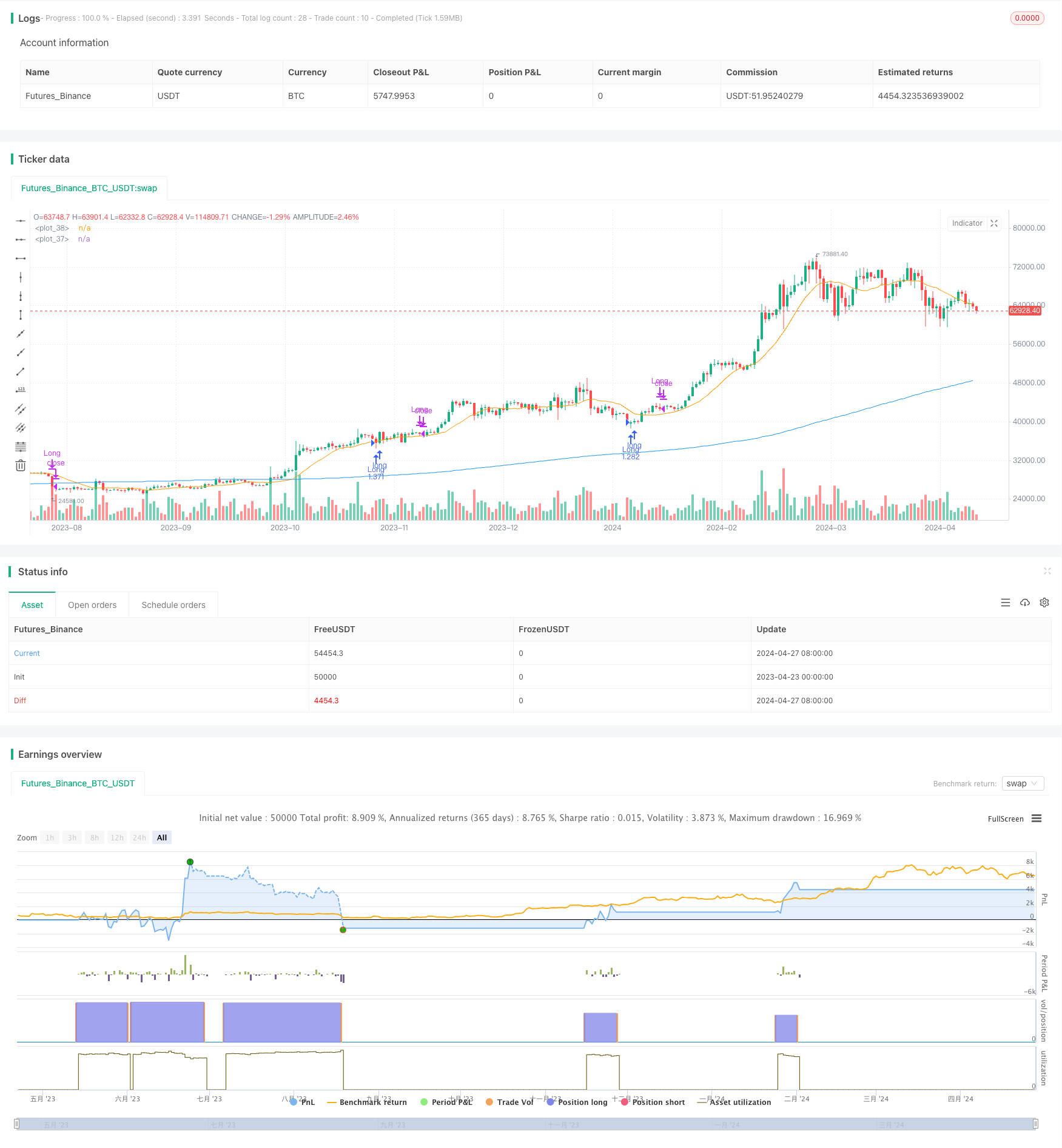
概述
该策略专注于1小时、2小时、3小时和4小时时间框架下的比特币(BTC)、币安币(BNB)和以太坊(ETH)。它旨在利用短期价格回撤,在更广泛的趋势中获利。通过识别趋势中的回撤,并使用烛台模式和超卖条件等确认信号,交易者可以在定义的风险和利润目标下进入头寸。有效的风险管理,包括止损单和头寸规模,是至关重要的。该策略提供了一种结构化的方法来交易回撤,同时管理下行风险。
策略原理
该策略使用两个简单移动平均线(SMA)来捕捉市场趋势和潜在的回撤机会。较长周期的SMA(ma1)作为趋势确认指标,而较短周期的SMA(ma2)用于识别价格偏离主要趋势的情况。当价格高于ma1时,表明上升趋势,策略寻找价格低于ma2的回撤作为潜在的买入机会。同时,该策略采用”Too Deep”和”Too Thin”参数来过滤回撤,以避免进入过深或过浅的回撤。一旦确认买入信号,该策略会以市价执行买入订单。平仓条件包括价格突破ma2上方或触发预设的止损水平。该策略利用趋势跟踪和回撤交易的原理,力求在趋势中抓住短期回调的机会。
策略优势
- 多时间框架分析:该策略在1小时、2小时、3小时和4小时时间框架下运行,提供了更全面的市场视角和潜在的交易机会。
- 趋势跟踪:通过使用较长周期的SMA作为趋势确认指标,该策略能够适应不同的市场趋势,并在趋势中寻找入场机会。
- 回撤交易:该策略专注于在上升趋势中寻找价格回撤,以更好的价格进场,同时降低了逆势交易的风险。
- 风险管理:该策略纳入了止损机制和头寸规模控制,以限制潜在的下行风险并保护交易资金。
- 参数优化:策略参数如移动平均线长度、止损百分比等可以根据市场状况和个人偏好进行优化,提供灵活性。
策略风险
- 参数敏感性:该策略的表现在一定程度上取决于所选参数,如移动平均线长度和回撤过滤器。参数的选择需要仔细的回测和优化。
- 市场噪音:短期价格波动可能导致虚假信号,从而进行不必要的交易并增加成本。
- 趋势反转:当市场趋势突然反转时,该策略可能面临潜在的损失,尤其是在止损位置被触发之前。
- 滑点和交易成本:频繁的交易可能导致较高的滑点和交易成本,影响策略的整体表现。
策略优化方向
- 动态止损:根据市场波动性或价格行为调整止损水平,以更好地应对不同的市场状况。
- 多因素确认:结合其他技术指标如相对强弱指数(RSI)或随机振荡器(Stochastic Oscillator)来确认趋势和回撤,提高信号可靠性。
- 风险调整头寸规模:根据当前市场波动性或个人风险偏好动态调整每笔交易的头寸规模。
- 交易时段优化:分析不同时段的价格行为和波动性,选择最佳的交易时段以提高策略表现。
- 加入市场情绪分析:结合市场情绪指标如恐惧贪婪指数,以更好地把握市场氛围和潜在的转折点。
总结
该多时间框架比特币、币安币和以太坊交易回撤策略提供了一种结构化的方法,在趋势中捕捉短期回调机会。通过结合趋势跟踪和回撤交易的原理,并应用适当的风险管理措施,该策略旨在优化潜在的交易机会。然而,策略的表现取决于参数选择和市场状况,需要持续的监控和优化。通过纳入动态止损、多因素确认和市场情绪分析等改进措施,可以进一步提升策略的稳健性和适应性。在实施该策略之前,全面的回测、参数优化和风险评估是至关重要的。
策略源码
/*backtest
start: 2023-04-23 00:00:00
end: 2024-04-28 00:00:00
period: 1d
basePeriod: 1h
exchanges: [{"eid":"Futures_Binance","currency":"BTC_USDT"}]
*/
// This Pine Script™ code is subject to the terms of the Mozilla Public License 2.0 at https://mozilla.org/MPL/2.0/
// © GOLU_PARDHAAN
//@version=5
strategy("Pullback stretegy", overlay=true,initial_capital = 1000,default_qty_type = strategy.percent_of_equity,default_qty_value = 100)
//input
ma_lenth1=input.int(200,'MA lenth 1',step=10,group = 'Moving avrege pprameter',inline = 'MA')
ma_lenth2=input.int(13,'MA lenth 2',step=1,group = 'Moving avrege pprameter',inline = 'MA')
sl=input.float(title = "stop loss%",defval=0.07,step=0.1,group = 'moving avrege pprameter')
too_deep=input.float(title = 'Too deep(%)',defval = 0.27,step=0.01,group='Too Deep and Too Thin',inline='Too')
too_thin=input.float(title = 'Too thin(%)',defval = 0.03,step=0.01,group='Too Deep and Too Thin',inline='Too')
//claulation
ma1=ta.sma(close,ma_lenth1)
ma2=ta.sma(close,ma_lenth2)
too_deep2= (ma2/ma1-1)<too_deep
too_thin2= (ma2/ma1-1)>too_thin
//entry and colose Conditionq
var float buy_price=0
buy_condition=(close>ma1)and(close<ma2)and strategy.position_size==0 and too_deep2 and too_thin2
close_condition1=(close>ma2)and strategy.position_size>0 and (close<low[1])
stop_distance=strategy.position_size>0? ((buy_price-close)/close): na
close_condition2=strategy.position_size>0 and stop_distance>sl
stop_price= strategy.position_size>0?buy_price-(buy_price*sl): na
//entry and close order
if buy_condition
strategy.entry('Long',strategy.long)
if buy_condition[1]
buy_price:=open
if close_condition1 or close_condition2
strategy.close('Long' ,comment = "exite"+(close_condition2 ? "SL=ture":""))
buy_price :=na
plot(ma1,color = color.blue)
plot(ma2,color = color.orange)
相关推荐